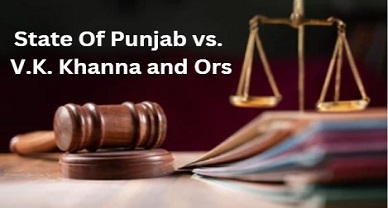As Is Where Is Clause and Requirements to Be Fulfilled By Banks during Auction of Secured Property
What is an ‘as is where is clause’?
In any contract the clause ‘as is where is’ implies that whatever is transferred by the way of that contracted is being accepted by the receiver in its existing condition with all its encumbrances and without any assurance or guarantee from the transferor. The buyer can inspect the property but they agree that the seller is not responsible for resolving any problems that they might find with the property if they have signed the contract containing this clause. This means that this clause puts a burden of the buyer to check and properly inspect the property before entering into a contract. In contracts containing such clauses it is assumed that the purchaser had the knowledge of any encumbrances that the property is containing.
Statutory validity of ‘as is where is’ clause
This clause can find its validity in the ‘Doctrine of Constructive Notice’ as found under Section 3 of the Transfer of Property Act 1882. This section states that as quoted below:
“a person is said to have notice of a fact when he actually knows that fact, or when, but for wilful abstention from an enquiry or search which he ought to have made, or gross negligence, he would have known it.
Explanation II.—Any person acquiring any immoveable property or any share or interest in any such property shall be deemed to have notice of the title, if any, of any person who is for the time being in actual possession thereof”.
‘Caveat Emptor’ and ‘As Is Where Is’ clause
Caveat emptor is a common law doctrine finding its origin from the case of Chandelor v Lupos[1]. This doctrine places the burden on a purchaser to inspect the property or any other thing that they are purchasing properly before making that purchase. Failing to do that when he had all the opportunity to do so, such purchaser cannot claim any recourse against the seller due to this doctrine.
On the other hand, the clause of ‘as is where is’ is specifically incorporated into real estate contracts by the seller to sell their property with all the encumbrances that it might be carrying. Sometimes this clause is deliberately used in property contracts by the seller to escape any liability or to cheat the buyer.
Validity of ‘As Is Where Is’ clause as per judicial pronouncements
In the case of Telangana State Southern Power Distribution Company Limited & another Vs. M/S. Srigdhaa Beverages[2], the right of the Bank to sell a secured asset on “As is where is whatever there is and without recourse basis” was firmly recognised and the purchaser was made liable to pay the electricity dues.
In the case of S. K. Bakshi Vs Punjab National Bank & Ors[3], the Jammu and Kashmir and Ladakh High Court recently ruled that
“No doubt, the Bank could auction the property even with encumbrances attached to property but it was incumbent upon the Bank to disclose the encumbrances and litigations on the same or tenancy, if any, attached to the property to all the persons who wanted to participate in the same and to the successful bidder. By including a clause of „as is where is‟ it would not be sufficient for respondent No. 1 from disclosing encumbrances or handing over the property to the petitioner”.
The validity of this clause was also recognised in the case of Punjab Urban Planning and Development Authority and Others vs Raghu Nath Gupta and Ors[4] where allotment/auction of plots/flats were made ‘as-is-where-is’ basis. The court held that
“after having accepted offer of commercial plots in a public auction with a superimposed condition i.e., on as-is-where-is basis and after having accepted the terms and conditions of allotment letter, including instalment facility for payment, respondents cannot say that they are not bound by the terms and conditions of auction notice and allotment letter”.
Can a Bank auction off a property with encumbrances under SARFAESI act relying on the ‘as-is-where-is’ clause?
Banks while auctioning off a secured asset under SARFAESI Act generally use the ‘as-is-where-is’ clause in the contract and while covering behind this clause auction off a property of which they don’t even have possession, leaving the purchaser with no recourse.
Now the main question that arises is that– Is a bank allowed to use this clause for escaping liability in such cases?

The Bombay High Court in the case of Medineutrina (P) Ltd. Vs District Industries Centre[5] held that even though the inclusion of the “as is where is” clause in a contract means that it is on the purchaser to make required inquiries about the property, it does not mean that mention of this clause or any other clause should absolve the secured creditor of its obligation to make proper enquiries about other encumbrances affecting the property and disclosing that information in the auction notice so that the purchaser can make conscious decision and not raise a plea of not having being informed before the purchase.
Also in the case of S. K. Bakshi Vs Punjab National Bank & Ors[6], the Jammu and Kashmir and Ladakh High Court held that
“No doubt, the Bank could auction the property even with encumbrances attached to property but it was incumbent upon the Bank to disclose the encumbrances and litigations on the same or tenancy, if any, attached to the property to all the persons who wanted to participate in the same and to the successful bidder. By including a clause of „as is where is‟ it would not be sufficient for respondent No. 1 from disclosing encumbrances or handing over the property to the petitioner”.
In the case of Anshu Agrawal v State of UP[7] it was held that The bank in question had the freedom to either acquire actual control of the secured asset before auctioning it or conduct the auction first and then secure physical possession afterward. According to the law, the petitioner cannot allege misrepresentation by the bank simply because the bank opted to auction the secured asset without initially obtaining physical possession.
Conclusion
After going through all the cases and explanations it can be clearly held that the Indian courts have recognised and upheld the validity of the “AS IS WHERE IS” clause. Also, even though they have recognised this clause, they have not left the purchaser completely helpless and held that in case where a bank auctions off property given to it as security and which has encumbrances attached to it, the bank cannot completely hide behind the ‘as is where is’ clause. The bank is required to do proper and reasonable enquiry regarding the encumbrances attached to the property being auctioned and mention those encumbrances in the auction notice. Only after this requirement has been fulfilled, the bank can rely on the clause as after that the complete burden to adopt due diligence before entering into the auction would be of the purchaser and the bank would then be free of its obligations.
Author: Kumari Srishti Agrawal, in case of any queries please contact/write back to us via email to chhavi@khuranaandkhurana.com or at Khurana & Khurana, Advocates and IP Attorney.
[1] (1603) Cro. Jac. 4, 79, ER 3
[2] (2020) 6 SCC 404.
[3] WP(C) No. 465/2021.
[4] Civil Appeals No. 5887 of 2012 with No. 5888 of 2012.
[5] (2021) 1 HCC (Bom) 32.
[6] WP(C) No. 465/2021.
[7] WRIT – C No. – 169 of 2021.


